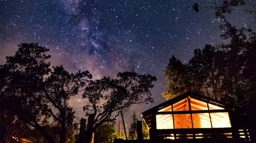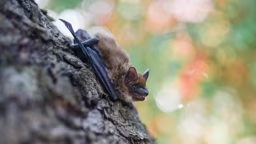Finding Home
Scientific understanding of bird migration still carries many mysteries. We are still not completely sure how birds navigate, though most authorities are in agreement that night migrants follow the magnetic fields of the earth and patterns in the night sky. Day migrants may actually use long-standing landmarks, learning the migratory traditions from older birds.
Birds have an amazing ability to time their migrations, matching their arrivals to the emergence of insects in the spring, the blooming of important wildflowers, the egg-laying activities of horseshoe crabs and other events that provide an abundance of food and the right environment for success. When a birdwatcher times a vacation as perfectly as the birds time their migration, the results can be spectacular.
In the light of early morning, after a long flight, large flocks will descend into the treetops and down into the marshes. To be there, awaiting their arrival, binoculars or camera in hand, is to be a kid again.
Brian Collins is a bird migration fanatic.
Scientific understanding of bird migration still carries many mysteries. We are still not completely sure how birds navigate, though most authorities are in agreement that night migrants follow the magnetic fields of the earth and patterns in the night sky. Day migrants may actually use long-standing landmarks, learning the migratory traditions from older birds.
Birds have an amazing ability to time their migrations, matching their arrivals to the emergence of insects in the spring, the blooming of important wildflowers, the egg-laying activities of horseshoe crabs and other events that provide an abundance of food and the right environment for success. When a birdwatcher times a vacation as perfectly as the birds time their migration, the results can be spectacular.
In the light of early morning, after a long flight, large flocks will descend into the treetops and down into the marshes. To be there, awaiting their arrival, binoculars or camera in hand, is to be a kid again.
Brian Collins is a bird migration fanatic.
As if floating in space, I sat peacefully in my canoe on placid waters. The night sky and its perfect reflection surrounded me, all around, above and below, broken only by a distant and dark shoreline. It was a new moon, and in the faint starlight, I could see my own breath and feel the night chill in still air. I listened – barely breathing – to hear evidence of the story unfolding above me.
From some nearby place between the lake and the stars above, I could hear the soft contact calls of migrating songbirds. Tiny “tsips,” barely audible “zrrts” provided proof of hundreds of songbirds in the night sky. They called out to stay together, and – though they flew in darkness – the patterns of the night sky and unseen magnetic fields told them the direction to keep flying.
I strained to see even a single star blotted out for a microsecond as a warbler or thrush passed by, but I could see nothing but endless stardust. The immensity of the night sky and the delicate sounds above painted a picture of heroism and uncertainty. Tiny birds challenged the chill of the night air. They expended tremendous energy to arrive somewhere they hadn’t seen in months, if ever at all.
Suddenly, very real to me, I could feel an adrenaline rush.
Without a doubt, the long distances covered by migrating birds are wrought with change and uncertainty, perils from land and air alike. The obstacles are both natural and man-made, ranging from birds of prey and unexpected shifts in weather to encounters with radio towers and skyscrapers. Since most of the birds are flying less than five hundred feet above terra firma, man-made structures are a common threat.
From some nearby place between the lake and the stars above, I could hear the soft contact calls of migrating songbirds. Tiny “tsips,” barely audible “zrrts” provided proof of hundreds of songbirds in the night sky. They called out to stay together, and – though they flew in darkness – the patterns of the night sky and unseen magnetic fields told them the direction to keep flying.
I strained to see even a single star blotted out for a microsecond as a warbler or thrush passed by, but I could see nothing but endless stardust. The immensity of the night sky and the delicate sounds above painted a picture of heroism and uncertainty. Tiny birds challenged the chill of the night air. They expended tremendous energy to arrive somewhere they hadn’t seen in months, if ever at all.
Suddenly, very real to me, I could feel an adrenaline rush.
Without a doubt, the long distances covered by migrating birds are wrought with change and uncertainty, perils from land and air alike. The obstacles are both natural and man-made, ranging from birds of prey and unexpected shifts in weather to encounters with radio towers and skyscrapers. Since most of the birds are flying less than five hundred feet above terra firma, man-made structures are a common threat.
The Nature of Migration
Migratory birds cover vast distances to secure food, nesting and a safe haven in winter. They are constantly in search of a better deal and a more accommodating environment. Migration is an action-packed, perilous way of life to which some birds devote almost all of their time.
Many birds that nest in Canada and the United States spend more months each year in the tropical habitats of Mexico, Central America and South America. These birds, often very colorful songbirds, begin arriving in the United States in mid-April and reach Canada before the first of June. They are gone again by October, sometimes even as early as August, migrating long and uncertain distances once again. The masses are detectable by radar, and, when weather is threatening, the birds may put down in gigantic flocks that fill habitats with a bustle of busy life – thrilling those birdwatchers lucky enough to intercept such an event.
Birds of all sorts inspire us, overcoming challenges or impressing with street savvy. Ruby-throated hummingbirds travel, unaided, across the Gulf of Mexico on a non-stop flight that takes a 24-hour day. Blackpoll warblers risk it all by taking a shortcut out over the Atlantic Ocean. Raptors instinctively and cautiously avoid big water, skirting shorelines in massive migratory waves. Flocks of waterfowl, shorebirds and songbirds arrive and fill scenic backwaters and forests with personality, vitality and drama.
While it may seem a dangerous and futile strategy, the risks of migration are strongly outweighed by the benefits to those that survive. Bountiful food and safer nesting grounds are the rewards for pushing the boundaries. In the face of Ice Ages and subsequent ecological successions, birds have adapted as pioneers –– exploring and settling in new surroundings. The mastery of a year’s migratory path is a mission accomplished not by any one individual but by an entire population.
Migratory birds cover vast distances to secure food, nesting and a safe haven in winter. They are constantly in search of a better deal and a more accommodating environment. Migration is an action-packed, perilous way of life to which some birds devote almost all of their time.
Many birds that nest in Canada and the United States spend more months each year in the tropical habitats of Mexico, Central America and South America. These birds, often very colorful songbirds, begin arriving in the United States in mid-April and reach Canada before the first of June. They are gone again by October, sometimes even as early as August, migrating long and uncertain distances once again. The masses are detectable by radar, and, when weather is threatening, the birds may put down in gigantic flocks that fill habitats with a bustle of busy life – thrilling those birdwatchers lucky enough to intercept such an event.
Birds of all sorts inspire us, overcoming challenges or impressing with street savvy. Ruby-throated hummingbirds travel, unaided, across the Gulf of Mexico on a non-stop flight that takes a 24-hour day. Blackpoll warblers risk it all by taking a shortcut out over the Atlantic Ocean. Raptors instinctively and cautiously avoid big water, skirting shorelines in massive migratory waves. Flocks of waterfowl, shorebirds and songbirds arrive and fill scenic backwaters and forests with personality, vitality and drama.
While it may seem a dangerous and futile strategy, the risks of migration are strongly outweighed by the benefits to those that survive. Bountiful food and safer nesting grounds are the rewards for pushing the boundaries. In the face of Ice Ages and subsequent ecological successions, birds have adapted as pioneers –– exploring and settling in new surroundings. The mastery of a year’s migratory path is a mission accomplished not by any one individual but by an entire population.
Migratory Stopovers
Migratory stopovers, as the name implies, are areas where birds pause for a while in the midst of their travels.
Migration is an energy-intensive business, pulling critical reserves from birds in a short amount of time. For this reason, rich and abundant food supplies in relatively safe habitats are essential for survival. Birds remain in these rich habitats for a few days while building back their fat reserves and passing the time with social bonding.
The bounty in a particular landscape often concentrates huge numbers of birds while they rest and feed. When the weather gets tough, birds may remain in their stopovers for many days, even weeks, providing ample opportunities for their human admirers.
Unbeknownst to the birds, their migration perils are an entertaining and intriguing spectacle for humans. Such stopovers have become world-famous birding locations. For a few weeks each year, birds by the thousands pile in, sometimes surprisingly tame in their quests for replenishment. They land in places with great habitats and great names, including:
• High Island, Texas
• Crex Meadows, Wis.
• Bosque del Apache, N.M.
• Cape May, N.J.
• Point Pelee, Ontario …
And the list goes on and on.
Migratory stopovers, as the name implies, are areas where birds pause for a while in the midst of their travels.
Migration is an energy-intensive business, pulling critical reserves from birds in a short amount of time. For this reason, rich and abundant food supplies in relatively safe habitats are essential for survival. Birds remain in these rich habitats for a few days while building back their fat reserves and passing the time with social bonding.
The bounty in a particular landscape often concentrates huge numbers of birds while they rest and feed. When the weather gets tough, birds may remain in their stopovers for many days, even weeks, providing ample opportunities for their human admirers.
Unbeknownst to the birds, their migration perils are an entertaining and intriguing spectacle for humans. Such stopovers have become world-famous birding locations. For a few weeks each year, birds by the thousands pile in, sometimes surprisingly tame in their quests for replenishment. They land in places with great habitats and great names, including:
• High Island, Texas
• Crex Meadows, Wis.
• Bosque del Apache, N.M.
• Cape May, N.J.
• Point Pelee, Ontario …
And the list goes on and on.













